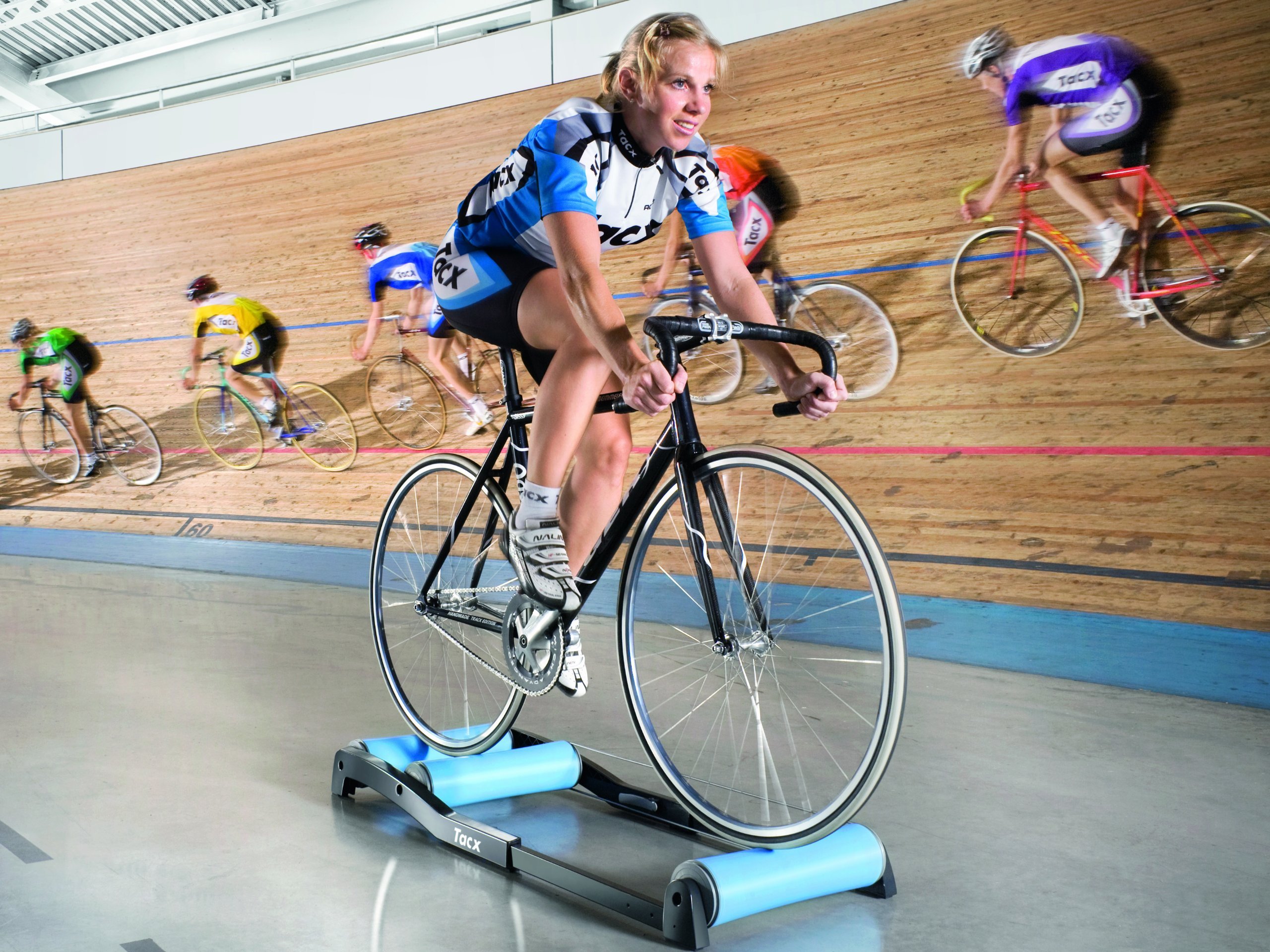Stationary bicycles need support to stop from falling over because they lack gyroscopic stabilization. Right?
If you ride a free bicycle on a treadmill (so both wheels are spinning) will it fall over or stay upright?
If you fall over on a treadmill, does it matter if this treadmill bicycle combo is on a train?
It will not fall over, although it is more difficult to keep upright. You can get bicycle “treadmills” (rollers) which let you ride in place similar to a stationary bike.

Tacx, the company that make those rollers, also make a bike trainer treadmill! (video review demonstrating them)
If I have one of these in my house and I go off the side would I crash right into the wall in front of me?
No, the energy in the wheels isn’t enough to accelerate the bike and your body very much. Either the wheels will spin without traction or you’ll lurch a little forward, or some combination of the two.
You can see the effect by lifting your rear wheel off the ground and spinning the tire up then dropping the bike back to the ground. The ground basically just acts like a brake.
Ah ok that makes sense.
Unlikely. You would still be accelerating your mass from zero, and you’d have plenty of time to stop pedaling. If you did it would be an extremely low-speed crash.
I’d say that riding off the side would be pretty likely to cause a loss of control though.
so still might want to wear a helmet, at least if you’re not very experienced
That would be wise, as well as having an assistant or a wall/doorway nearby to steady you.
Yes! The gyroscopic force of the bike will completely bypass the braking force of the ground and will be transferred directly onto your body, forcing you to cartwheel like a sideways helicopter into the wall in front of you. Beware! Bewaare!
This is what I imagine in my mind, but since I don’t see hundreds of YouTube videos of this happening, I guess that’s not how it works.
Not seeing the correct answer here. Though the gyroscopic effect helps a little, it’s minor. If you ever did the experiment in school where the teacher had you hold a spinning bicycle wheel on a handle, you know the effect is there, but you also know it doesn’t take all your body weight to overcome it.
The real answer is steering: on a moving bike, if you start to lean one direction, you can just turn the handlebars slightly to turn into it. That’s why on a bike moving slowly, you find yourself steering back and forth like crazy to maintain balance, but on a fast moving bike it seems almost effortless. Also, the way bikes are designed, they’re somewhat self-correcting: if you lean over on a moving bike, the wheel turns to that direction.
On a treadmill, both the gyroscopic effect and the ability to steer into the fall should be in place, so I think it should be stable.
The gyroscopic effect works, even if you hold just a single wheel on its axle and give it a few pushes.
A bicycle isn’t properly stable even when the wheels are turning. It’s statically stable, where it may keep it orientation with slight disturbances. But it will tend to fall over. It’s the person on the bike adjusting their weight that makes the bicycle dynamically stable. Where it will return to its upright position reliably.
The gyroscopic effect does help the cyclist keep the bicycle dynamically stable. As you would know from using a bike. However, the cyclists is the main factor in keeping the bike upright. BMX cyclists often keep the bike upright when stationary, often with the brakes applied.
If you very accurately balance a bike and hold it while it gets up to speed on a treadmill it may stay upright for a while. However any small motion will through it off balance. The bike will also slow down relative to the treadmill as the force of the treadmill will push it backwards once you release the bike. I don’t imagine it staying on the treadmill for more than a few seconds.
In order to keep it on the treadmill and upright you will have to pedal the bike to match the treadmill speed. You will also need to move weight on the bike to keep it upright. The moving weight will be the main thing that keeps it upright.
This will be very difficult as you need to very accurately match the speed of the treadmill to stay on it - unless you get a very long treadmill.
Does it matter if this in in a train? It would be the same as any other room, except the vibrations of the train would make it harder to balance the bike. When the train accelerates and decelerates the bike will see either more slip or the cyclist will have to counter the force caused by the changing speed by cycling faster or braking.
If it’s on top of the train you would also need to counter the effect of drag when cycling on the treadmill.
Then explain a motorcycle. The only time the rider is balancing it is in turns to keep from falling off theselves. Otherwise, when moving, it’s self balancing in a straight line. It IS the gyroscope effect. Weight shifting only applies if there is an imbalance causing it to not be stable in the first place.
The treadmill will not work because the bike has no forward momentum pulling it upright. The wheels spin, but the frame doesn’t move. There are no forcing acting on the frame to keep it up, so you will need to use your body and balance it like a seesaw(side to side)
The second part contradicts the first part though.
If it’s the gyroscopic effects keeping the bike up then all that needs to happen is the wheels need to spin. After all it’s spinning wheels that create those gyroscopic effects.
I think this is more like orbiting. You’re moving forward faster than you are moving sideways which is what keeps you upright mixed with the gyroscopic nature of bike wheels.
Yeah, I think orbiting is a better analogy.
It’s not the gyroscope effect.
If it was, you’re talking about a force capable of keeping 200-300kg vehicle upright with mechanical disadvantage (the height of the bike vs the wheels on the floor)
If that was the case, how would you steer the bike with just 80cm of handlebar? Even if you divide the force between two wheels and the motor you’re still looking at 100kg of force to overcome steering.
deleted by creator
Treadmills aren’t really that smooth, so, despite the stabilization of gyroscopic motion, enough wobble would creep in from the slightly uneven surface to eventually topple the bicycle.
But it would probably stay upright for a short while, as long as the handlebars were somehow locked into a straight and forward position.




